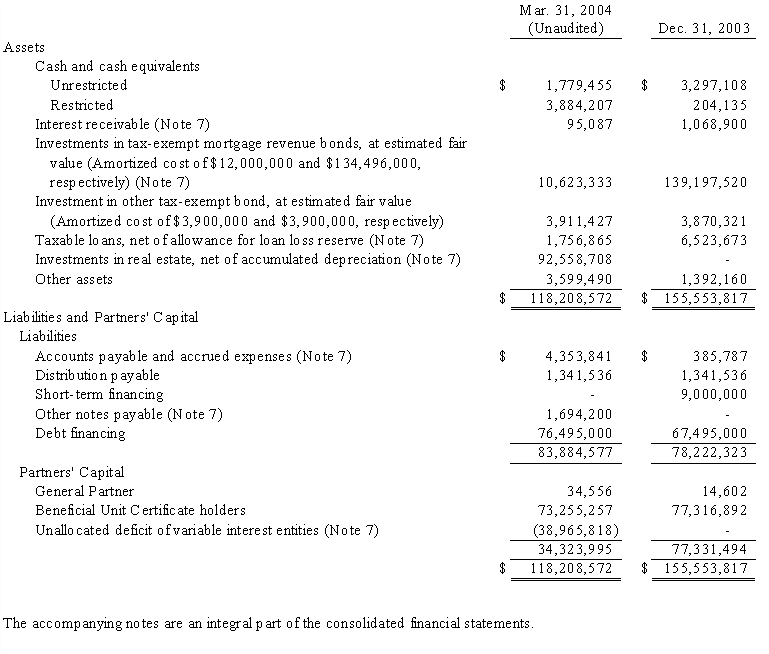
UNITED STATES
SECURITIES AND EXCHANGE COMMISSION
Washington, D.C. 20549
FORM 10-Q
[X] QUARTERLY REPORT PURSUANT TO SECTION 13 OR 15(d) OF THE SECURITIES EXCHANGE ACT OF 1934
For the quarterly period ended March 31, 2004
OR
[ ] TRANSITION REPORT PURSUANT TO SECTION 13 OR 15(d) OF THE SECURITIES
EXCHANGE ACT OF 1934
For the transition period from to
Commission File Number: 000-24843
AMERICA FIRST TAX EXEMPT INVESTORS, L.P.
(Exact name of registrant as specified in its charter)
Delaware 47-0810385
(State or other jurisdiction (I.R.S. Employer
of incorporation or organization) Identification No.)
1004 Farnam Street, Suite 400 Omaha, Nebraska 68102
(Address of principal executive offices) (Zip Code)
(402) 444-1630
(Registrant's telephone number, including area code)
Indicate by check mark whether the registrant (1) has filed all reports required to be filed by Section 13 or 15(d) of the Securities Exchange Act of 1934 during the preceding 12 months (or for such shorter period that the registrant was required to file such reports), and (2) has been subject to such filing requirements for the past 90 days.
YES [ X ] NO [ ]
Indicate by check mark whether the registrant is an accelerated filer (as defined in Exchange Act Rule 12b-2 of the Exchange Act).
YES [ ] NO [ X ]
INDEX
PART I - FINANCIAL INFORMATION
Consolidated Balance Sheets as of March 31, 2004 (Unaudited) and December 31, 2003
Consolidated Statements of Operations and Comprehensive Income (Loss)
for the three months ended March 31, 2004 and 2003 (Unaudited)
Consolidated Statement of Partners' Capital for the three months ended March 31, 2004
(Unaudited)
Consolidated Statements of Cash Flows for the three months ended March 31, 2004 and
2003 (Unaudited)
Notes to Consolidated Financial Statements (Unaudited)
Item 2. Management's Discussion and Analysis of Financial Condition and Results of Operations
Item 3. Quantitative and Qualitative Disclosures About Market Risk
Item 4. Controls and Procedures
PART II - OTHER INFORMATION
Item 6. Exhibits and Reports on Form 8-K
PART I - FINANCIAL INFORMATION
AMERICA FIRST TAX EXEMPT INVESTORS, L.P.
CONSOLIDATED BALANCE SHEETS

AMERICA FIRST TAX EXEMPT INVESTORS, L.P.
CONSOLIDATED STATEMENTS OF OPERATIONS AND COMPREHENSIVE INCOME (LOSS)
(UNAUDITED)
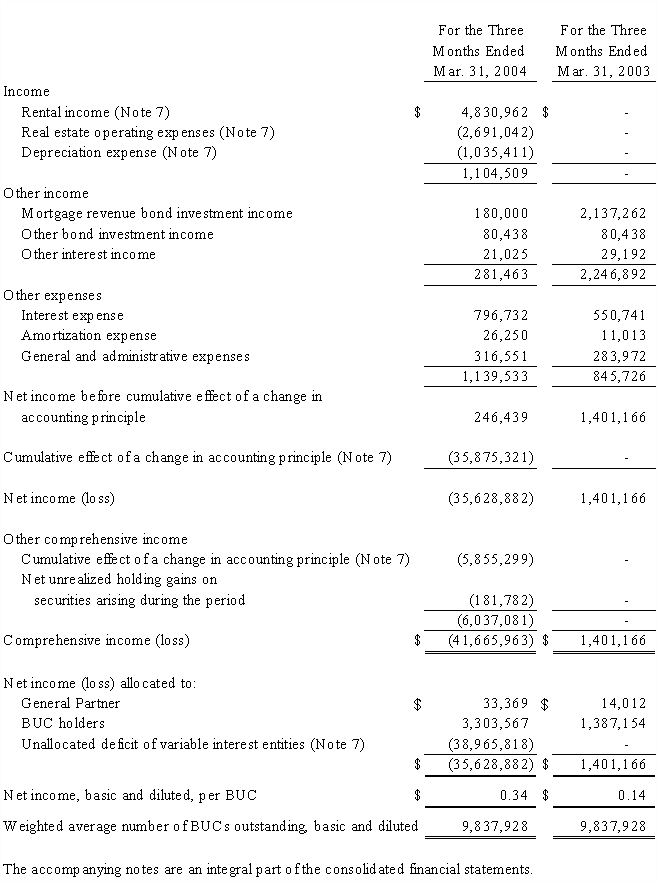
AMERICA FIRST TAX EXEMPT INVESTORS, L.P.
CONSOLIDATED STATEMENT OF PARTNERS' CAPITAL
FOR THE THREE MONTHS ENDED MARCH 31, 2004
(UNAUDITED)
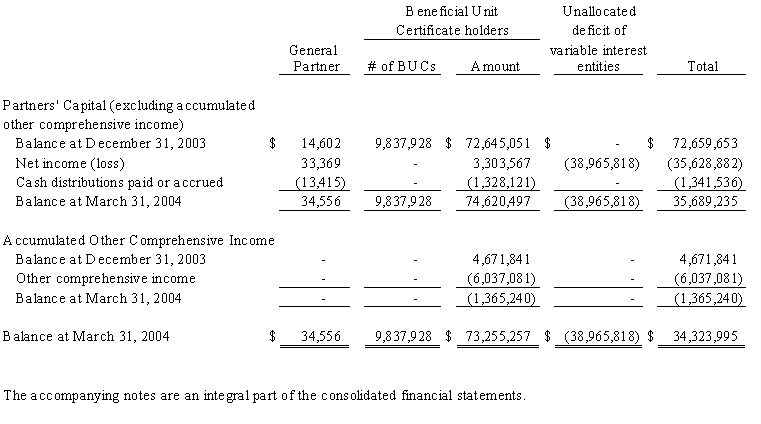
AMERICA FIRST TAX EXEMPT INVESTORS, L.P.
CONSOLIDATED STATEMENTS OF CASH FLOWS
(UNAUDITED)
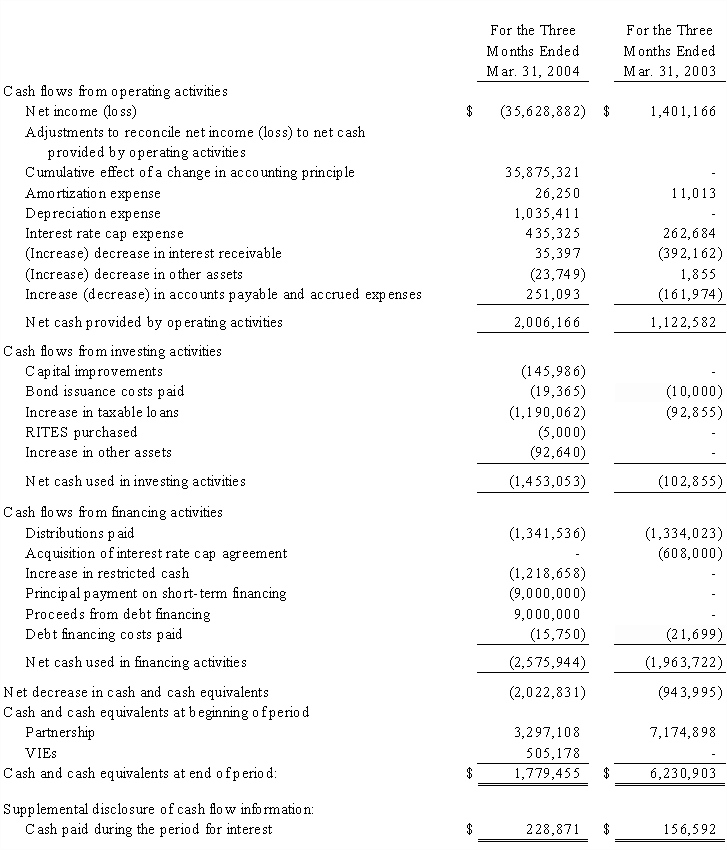 The accompanying notes are an integral part of the consolidated financial statements.
The accompanying notes are an integral part of the consolidated financial statements.
1. Basis of Presentation
America First Tax Exempt Investors, L.P. (the "Partnership") is a Delaware corporation formed for the purpose of acquiring, holding, selling and otherwise dealing with a portfolio of federally tax-exempt mortgage revenue bonds which have been issued to provide construction and/or permanent financing of multifamily residential apartments.
The accompanying interim unaudited consolidated financial statements have been prepared according to the rules and regulations of the Securities and Exchange Commission. Certain information and footnote disclosures normally included in financial statements prepared in accordance with accounting principles generally accepted in the United States of America ("GAAP") have been condensed or omitted according to such rules and regulations, although management believes that the disclosures are adequate to make the information presented not misleading. The consolidated financial statements should be read in conjunction with the financial statements and notes thereto included in the Partnership's Annual Report on Form 10-K as of and for the year ended December 31, 2003. Certain amounts from prior periods have been reclassified to conform to the current period presentation. In the opinion of management, all normal and recurring adjustments necessary to present fairly the financial position as of March 31, 2004, and the results of operations for all periods presented have been made. The results of operations for the three month period ended March 31, 2004 are not necessarily indicative of the results to be expected for the full year.
The consolidated financial statements include the accounts of the Partnership and variable interest entities ("VIEs") for which the Partnership has been determined to be the primary beneficiary. All significant transactions and accounts between the Partnership and the VIEs have been eliminated in consolidation. The preparation of financial statements in conformity with GAAP requires management to make estimates and assumptions that affect the reported amounts of assets and liabilities and disclosure of contingent assets and liabilities at the date of the financial statements and the reported amounts of revenues and expenses during the reporting period. Actual results could differ from those estimates.
The Partnership does not presently believe that the consolidation of VIE's for reporting under GAAP will impact the Partnership's tax status, amounts reported to BUC holders on IRS Form K-1, the Partnership's ability to distribute tax-exempt interest to BUC holders, the current level of quarterly distributions or the tax-exempt status of the underlying properties.
New Accounting Pronouncements
In January 2003, the Financial Accounting Standards Board ("FASB") issued FASB Interpretation No. 46, Consolidation of Variable Interest Entities an interpretation of ARB 51 ("FIN 46"). A modification to FIN 46 was released in December 2003 (FIN 46R). The Partnership is required to apply FIN 46R to variable interests in VIEs created after December 31, 2003. For variable interests in VIEs created before January 1, 2004, the interpretation is to be applied by March 31, 2004. FIN 46, as revised by FIN 46R, clarifies the application of existing accounting pronouncements to certain entities in which equity investors do not have the characteristics of a controlling financial interest or do not have sufficient equity at risk for the entity to finance its activities without additional subordinated financial support from other parties. Such entities are considered VIEs.
FIN 46R is a complex standard that requires significant analysis and judgment. With respect to the multifamily properties which collateralize certain of the Partnership's tax-exempt mortgage revenue bonds, management has determined that all but one of the entities which own the multifamily properties are VIEs of the Partnership. In addition, management has determined that the Partnership is the primary beneficiary of such VIEs pursuant to the terms of each tax-exempt mortgage revenue bond and the criteria within FIN 46R. Therefore, the Partnership is required to consolidate the results of each VIE's multifamily property into the Partnership's financial statements. Because each of the VIEs required to be consolidated was created before January 1, 2004, the assets and liabilities of the VIEs have initially been measured at their carrying amounts with the net amount added to the balance sheet being recognized as the cumulative effect of a change in accounting principle.
The Partnership has elected to implement FIN 46R as of January 1, 2004 so as to provide a consistent presentation in all financial statements throughout 2004. As of January 1, 2004, the Partnership recorded a $37.8 million loss on the cumulative effect of a change in accounting principle as a result of recording the net deficit allocable to the Partnership's variable interest in the VIEs. As of January 1, 2004, the Partnership recorded net assets of these VIEs, consisting primarily of $2.5 million in restricted cash, $0.5 million in unrestricted cash, $93.5 million in investments in real estate, $2.6 million in other assets, $3.7 million in accounts payable and accrued expenses, $10.7 million in notes and interest payable and the $122.5 million in bonds payable. See Note 7 for further discussion.
The following updates the Partnership's accounting policies as a result of the consolidation of VIEs:
Cash Equivalents
Cash equivalents include highly liquid securities and investments in federally tax-exempt securities with original maturities of three months or less when purchased. Restricted cash and cash equivalents, which is legally restricted to use, is comprised of resident security deposits, required maintenance reserves, escrowed funds and collateral for interest rate cap agreements. In addition, the Partnership must maintain unencumbered cash of $609,000 per the related collateral agreements.
Investments in Real Estate
The Partnership's investments in real estate are carried at cost less accumulated depreciation. Depreciation of real estate is based on the estimated useful life of the related asset, generally 27-1/2 years on multifamily residential apartment buildings and five to fifteen years on capital improvements and is calculated using the straight-line method. Maintenance and repairs are charged to expense as incurred, while significant improvements, renovations and replacements are capitalized.
Management reviews each property for impairment at least annually and whenever events or changes in circumstances indicate that the carrying value of a property may not be recoverable. The review of recoverability is based upon comparing the net book value of each real estate property to the sum of its estimated undiscounted future cash flows. If impairment exists due to the inability to recover the carrying value of a property, an impairment loss is recorded to the extent that the carrying value of the property exceeds its estimated fair value. There were no impairment losses incurred and/or recorded for the three months ended March 31, 2004.
Revenue Recognition on Investments in Real Estate
The Partnership's VIEs lease multifamily rental units under operating leases with terms of one year or less. Rental revenue is recognized as earned, net of rental concessions, which approximates the straight-line method over the related lease term.
2. Partnership Income, Expenses and Cash Distributions
The Agreement of Limited Partnership of the Partnership contains provisions for the distribution of Net Interest Income, Net Residual Proceeds and Liquidation Proceeds (as defined in the Agreement of Limited Partnership) and for the allocation of income and loss from operations and allocation of income and loss arising from a repayment, sale or liquidation.
The unallocated deficit of the VIEs is primarily comprised of the accumulated historical net losses of the VIEs and the three months ended March 31, 2004 VIEs net loss of $1,130,497. The loss resulting from the consolidation of the VIEs is not allocated between the General Partner and BUC holders.
The Partnership plans to make cash distributions on a quarterly basis; however, distributions may be made on a monthly or semiannual basis if the General Partner so elects.
3. Investments in Real Estate
The Partnership's VIE's investments in real estate as of March 31, 2004 are comprised of the following:
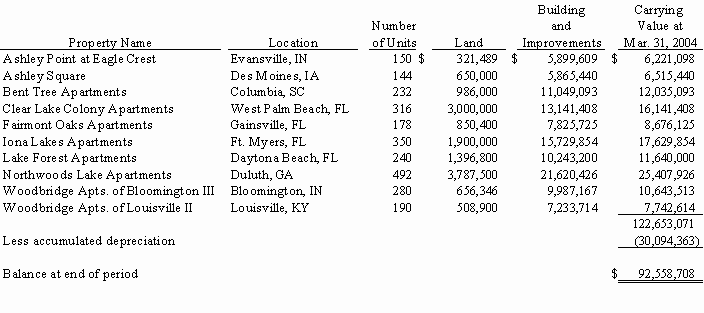
4. Debt Financing
The Partnership's debt financing bears interest at a weekly floating bond rate plus remarketing, credit enhancement, liquidity and trustee fees, which averaged 1.75% and 1.93% for the three months ended March 31, 2004 and 2003, respectively.
5. Related Party Transactions
The General Partner is entitled to receive an administrative fee from the Partnership up to 0.45% of the outstanding principal balance of any tax-exempt mortgage revenue bond or other mortgage investment, unless the owner of the property financed by such tax-exempt mortgage revenue bond or other mortgage investment or another third party is required to pay such administrative fee. For the three month periods ended March 31, 2004 and 2003, the Partnership's administrative fees to the General Partner were $17,887 and $4,388 respectively. The Partnership may become obligated to pay additional administrative fees to the General Partner in the event the Partnership acquires additional tax-exempt mortgage revenue bonds or other mortgage investments and is not able to negotiate the payment of these fees by the property owners or in the event the Partnership acquires title to any of the properties securing its existing tax-exempt mortgage revenue bonds by reason of foreclosure. Additionally, the General Partner received administrative fees of $104,254 and $69,169 for the three month periods ended March 31, 2004 and 2003, respectively, from the owners of properties financed by the tax-exempt mortgage revenue bonds held by the Partnership. These administrative fees are payable by the property owners prior to the payment of any contingent interest on the tax-exempt mortgage revenue bonds secured by the respective properties.
The General Partner remains entitled to receive approximately $359,000 in administrative fees from the Partnership for the year ended December 31, 1989. The payment of these fees, which has been deferred by the General Partner, is contingent upon, and will be paid only out of future profits realized by the Partnership from the disposition of any Partnership assets. These deferred fees will be recorded as an expense by the Partnership when it is probable that these fees will be paid.
An affiliate of the General Partner was retained to provide property management services for Ashley Pointe at Eagle Crest, Ashley Square, Bent Tree Apartments, Clear Lake Colony Apartments, Chandler Creek Apartments (beginning in February 2004), Fairmont Oaks Apartments, Iona Lakes Apartments, Lake Forest Apartments, and Northwoods Lake Apartments. The management fees paid by the property owners to the affiliate of the General Partner amounted to $165,506 and $158,867 for the three month periods ended March 31, 2004 and 2003, respectively. These property management fees are paid by the respective properties prior to the payment of any interest on the tax-exempt mortgage revenue bonds and taxable loans held by the Partnership on these properties.
6. Interest Rate Cap Agreements
The Partnership has entered into three derivative agreements in order to mitigate its exposure to interest rates on its variable-rate debt financing.
On July 1, 2002, the Partnership purchased an interest rate cap from Bear Stearns Financial Products, Inc. The interest rate cap was purchased at a $489,000 premium, has a cap on the floating rate index of 3.0%, has a notional amount of $20,000,000 and matures on July 1, 2006. It effectively caps the floating rate index (the BMA Municipal Index) at 3.0%, so the maximum interest rate to be paid on $20,000,000 of debt financing is 3.0% plus remarketing, credit enhancement, liquidity and trustee fees which aggregate to approximately 90 basis points.
On November 1, 2002, the Partnership purchased a convertible interest rate cap from Bank of America. The convertible interest rate cap was purchased at a $250,000 premium, has a cap on the floating rate index of 3.0%, has a notional amount of $10,000,000 and matures on November 1, 2007. It effectively caps the floating rate index at 3.0%, so the maximum interest rate to be paid on $10,000,000 of debt financing is 3.0% plus remarketing, credit enhancement, liquidity and trustee fees which aggregate to approximately 90 basis points. If the floating rate index declines to a level where Bank of America elects to exercise its option, the convertible cap would be converted to a fixed rate swap and the Partnership's interest expense would be converted to a fixed rate of 2.6% plus remarketing, credit enhancement, liquidity and trustee fees which aggregate to approximately 90 basis points for the remaining term of the agreement.
On February 1, 2003, the Partnership purchased a convertible interest rate cap from Bank of America. The convertible interest rate cap was purchased at a $608,000 premium, has a cap on the floating rate index of 3.50%, has a notional amount of $15,000,000 and matures on January 1, 2010. It effectively caps the floating rate index at 3.50%, so the maximum interest rate to be paid on $15,000,000 of debt financing is 3.50% plus remarketing, credit enhancement, liquidity and trustee fees which aggregate to approximately 90 basis points. If the floating rate index declines to a level where Bank of America elects to exercise its option, the convertible cap would be converted to a fixed rate swap and the Partnership's interest expense would be converted to a fixed rate of 2.95% plus remarketing, credit enhancement, liquidity and trustee fees which aggregate to approximately 90 basis points for the remaining term of the agreement.
Interest rate cap expense, which is the result of marking the interest rate cap agreements to market, was $435,325 and $262,684 for the three month periods ended March 31, 2004 and 2003, respectively, and is included as a component of interest expense in the accompanying financial statements.
7. Consolidation of VIEs
With respect to the multifamily properties which collateralize certain of the Partnership's tax-exempt mortgage revenue bonds, management has determined that all but one of the entities which own the multifamily properties are VIEs as defined by FIN 46R. In addition, management has determined that the Partnership is the primary beneficiary of such VIEs pursuant to the terms of each tax-exempt mortgage revenue bond and the criteria included in FIN 46R. Therefore, as required by FIN 46R, the Partnership must consolidate the results of each applicable multifamily property into its financial statements. The carrying amounts of the properties collateralizing the Partnership's tax-exempt mortgage revenue bonds are shown on the balance sheet as Investments in real estate and are detailed in Note 3.
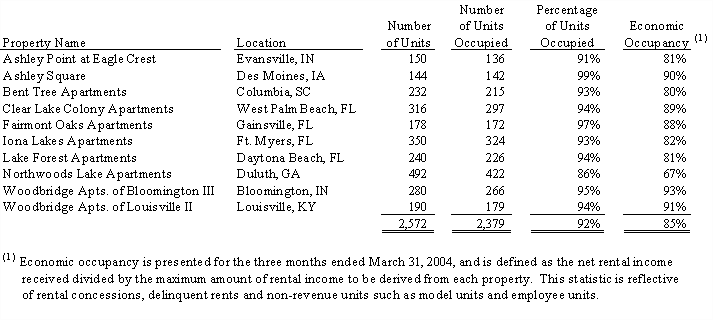
The Partnership's maximum exposure to loss from these VIE's is represented by the tax-exempt mortgage revenue bonds owned by the Partnership and taxable loans made by the Partnership to the properties. The following tables provide information regarding the tax-exempt mortgage revenue bonds and the taxable loans which have been eliminated in the consolidation of the VIE's.


The fair market value ("FMV") of the tax-exempt mortgage revenue bonds as of March 31, 2004 and December 31, 2003 are as follows:
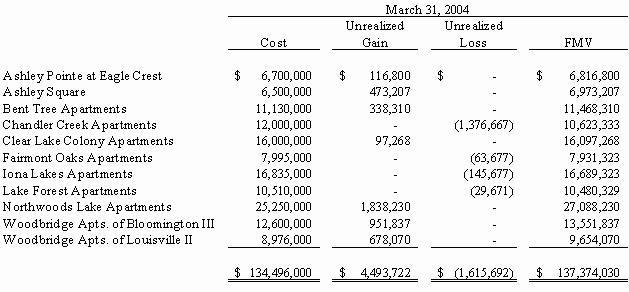
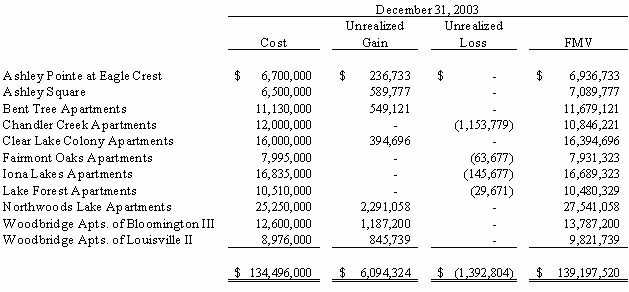
The following details the consolidation of the VIEs as of and for the three months ended March 31, 2004 and the impact on the Partnership's stand-alone financial statements:
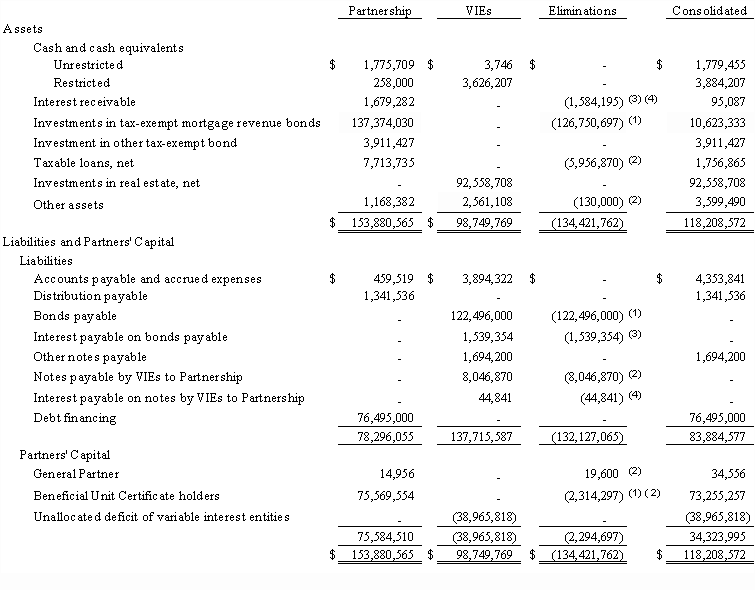
(1)
Elimination of investment in tax-exempt mortgage revenue bonds and related bonds payable.(2)
Elimination of taxable loans between the Partnership and the VIEs with related loan loss provision and related notes payable.(3)
Elimination of interest receivable related to tax-exempt mortgage revenue bonds and related bonds payable along with offsetting interest payable.(4)
Elimination of interest receivable related to taxable loans.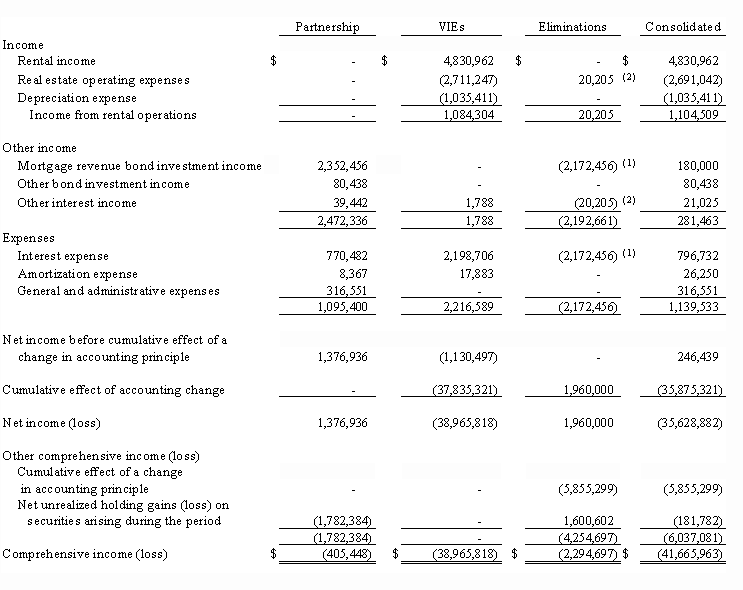
(1)
Elimination of interest income related to investment in tax-exempt mortgage revenue bonds and interest expense related to bonds payable.(2)
Elimination of interest income related to taxable loans.The Partnership does not presently believe that the consolidation of VIE's for reporting under GAAP will impact the Partnership's tax status, amounts reported to BUC holders on IRS Form K-1, the Partnership's ability to distribute tax-exempt income to BUC holders, the current level of quarterly distributions or the tax-exempt status of the underlying properties.
8. Segment Reporting
The Partnership defines each of its multifamily apartment properties being consolidated under FIN 46R as an individual operating segment. It has determined that all multifamily apartment properties have similar economic characteristics and meet the other criteria which permit the multifamily apartment properties to be aggregated into one reportable segment; that being the acquiring, holding, operating and selling of multifamily apartment properties. Prior to the application of FIN 46R as of January 1, 2004, the Partnership did not have more than one reportable segment.
The revenues, net income, net operating income and total assets for the Company's reportable segment as of or for the three month periods ended March 31, 2004 are summarized as follows
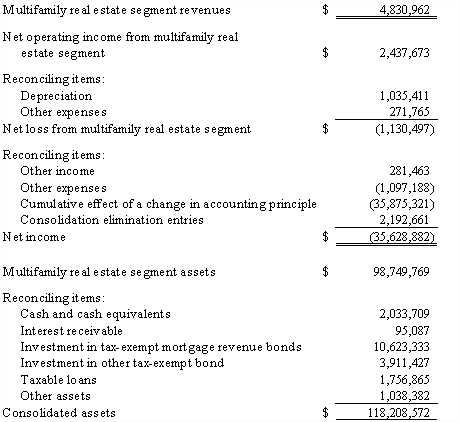
The Company does not derive any of its consolidated revenues from foreign countries and does not have any major customers that individually account for 10% or more of the Company's consolidated revenues.
9. Subsequent Event
On May 7, 2004, the taxable loan made by the Partnership to Clarkson College was repaid from the proceeds from approximately $2.8 million of tax exempt mortgage revenue bonds issued to provide permanent financing for a 140-unit student housing project. The Partnership will provide the entire amount of the permanent financing which is expected to total $6.2 million. The remaining $3.4 million of financing is expected to be funded in 2004.
Item 2. Management's Discussion and Analysis of Financial Condition and Results of Operations.
Forward-Looking Statements
This report (including, but not limited to, the information contained in "Management's Discussion and Analysis of Financial Condition and Results of Operations") contains forward-looking statements that reflect management's current beliefs and estimates of future economic circumstances, industry conditions, the Partnership's performance and financial results. All statements, trend analysis and other information concerning possible or assumed future results of operations of the Partnership and the investments it has made constitute forward-looking statements. BUC holders and others should understand that these forward-looking statements are subject to numerous risks and uncertainties and a number of factors could affect the future results of the Partnership and could cause those results to differ materially from those expressed in the forward-looking statements contained herein. These factors include general economic and business conditions such as the availability and credit worthiness of prospective tenants, lease rents, operating expenses, the terms and availability of financing for properties financed by the tax-exempt mortgage revenue bonds owned by the Partnership, adverse changes in the real estate markets from governmental or legislative forces, lack of availability and credit worthiness of counter parties to finance future acquisitions and interest rate fluctuations.
Critical Accounting Policies
The Partnership's critical accounting policies are the same as those described in the Partnership's Annual Report on Form 10-K as of and for the year ended December 31, 2003 with the addition of the following:
Variable interest entities (VIEs)
When the Partnership invests in a tax-exempt mortgage revenue bond which is collateralized by the underlying multifamily property, the Partnership will evaluate the entity which issued the tax-exempt mortgage revenue bond to determine if it is a VIE as defined by FIN 46R. If it is determined that the entity is a VIE, the Partnership will then evaluate if it is the primary beneficiary of such VIE. If the Partnership determines itself to be the primary beneficiary of the VIE, then the financial results of the related multi-family property will be consolidated in the Partnership's financial statements. As a result of such consolidation, the tax-exempt or taxable debt financing provided by the Partnership to such consolidated VIE will be eliminated as part of the consolidation process. However, the Partnership will continue to receive interest and principal payments on such debt and these payments will retain their characterization as tax-exempt or taxable, as the case may be.
General
The Partnership was formed for the primary purpose of acquiring, holding, selling and otherwise dealing with a portfolio of federally tax-exempt mortgage revenue bonds which have been issued to provide construction and/or permanent financing of multifamily residential apartments. The Partnership's business objectives are to: (i) preserve and protect its capital; (ii) provide regular cash distributions to BUC holders; and (iii) provide a potential for an enhanced federally tax-exempt yield as a result of a participation interest in the net cash flow and net capital appreciation of the underlying real estate properties financed by the tax-exempt mortgage revenue bonds.
The Partnership is pursuing a business strategy of acquiring additional tax-exempt mortgage revenue bonds on a leveraged basis in order to: (i) increase the amount of tax-exempt interest available for distribution to its BUC holders; (ii) reduce risk through asset diversification and interest rate hedging; and (iii) achieve economies of scale. The Partnership seeks to achieve its investment growth strategy by investing in additional tax-exempt mortgage revenue bonds and related investments, taking advantage of attractive financing structures available in the tax-exempt securities market and entering into interest rate risk management instruments.
The Partnership's primary assets are its tax-exempt mortgage revenue bonds, which provide permanent financing for eleven multifamily housing properties. A description of the multifamily housing properties collateralizing the tax-exempt mortgage revenue bonds owned by the Partnership as of March 31, 2004 is as follows:
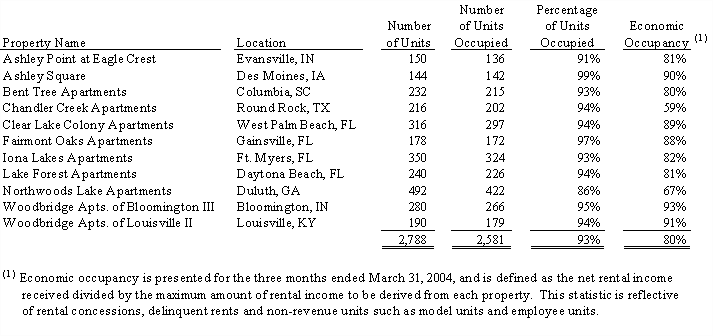
The consolidation of VIEs under FIN 46R changes the presentation of financial information in the financial statements but does not change the Partnership's primary purpose, business objectives or the primary assets the Partnership holds to meet its purpose and objectives. Going forward, the Partnership's financial statements will present consolidated financial information of the underlying properties as compared to the interest income generated from the tax-exempt mortgage bonds and taxable mortgage loans made by the Partnership to finance these properties.
Executive Summary
The multifamily housing industry is experiencing soft market conditions which are attributable to three factors: (i) recessionary conditions in certain markets; (ii) over-building of apartment properties; and (iii) record levels of single family home purchases largely due to record low mortgage interest rates. These factors have reduced the availability and increased the competition for credit worthy tenants, which in turn reduces effective rents in the form of concessions and increases operating costs such as leasing incentives. As of March 31, 2004, all of the Partnership's tax-exempt mortgage revenue bonds were paying their full amount of base interest; however, a prolonged weakened economy and the resulting decline in net rental revenues from the Partnership's collateral of multifamily properties may negatively impact future interest income. At certain properties the decline in net rental income may last for an extended period. As a result, the Partnership has the ability and may restructure the terms of the related tax-exempt mortgage revenue bond to reduce the base interest rate. However, as of March 31, 2004, the Partnership had not restructured the terms of any of the tax-exempt mortgage revenue bonds to reduce the base interest rate. Furthermore, the collection of contingent interest payable from the excess cash flow of the underlying properties may decrease significantly in times of economic slowdown. The Partnership remains aware of this potential and continues to monitor the performance of the multifamily properties collateralizing its tax-exempt mortgage revenue bonds. Offsetting these weak conditions are the positive economic benefits the Partnership is experiencing from the record low interest rates it is paying on its variable-rate debt.
The following is a summary of significant items or events that have had or could have an effect on the Partnership's financial position, results of operations, and liquidity:
Results of Operations
The following discussion of the Partnership's results of operations for the three month period ended March 31, 2004 should be read in conjunction with the consolidated financial statements and notes thereto included in Item 1 of this report as well as the Partnership's Annual Report on Form 10-K as of and for the year ended December 31, 2003.
Change in Results of Operations (Consolidated)
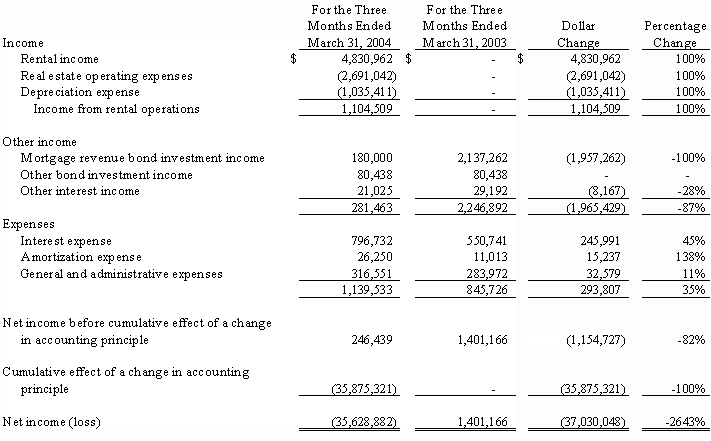
Three Months Ended March 31, 2004 Compared to Three Months Ended March 31, 2003
Rental income. Rental income in the current period is the result of consolidating the VIEs. The rental income recognized is reflective of current physical occupancy of 93% and economic occupancy of 80% for the three months ended March 31, 2004. The Partnership expects both physical and economic occupancy to increase slightly during 2004 which in turn should cause rental income to increase.
Real estate operating expenses. Real estate operating expenses in the current period is the result of consolidating the VIEs. Real estate operating expenses are comprised principally of real estate taxes, property insurance, utilities, property management fees, repairs and maintenance, and salaries and related employee expenses of on-site employees. A portion of real estate operating expenses are fixed in nature, thus an increase in physical and economic occupancy would result in slightly larger margins as these real estate operating expenses would not increase at the same rate.
Depreciation expense. Depreciation expense in the current period is the result of consolidating the VIEs. This expense should remain fairly consistent from quarter to quarter throughout 2004.
Mortgage revenue bond investment income. Mortgage revenue bond investment income, with the exception of Chandler Creek, is eliminated in consolidation of the VIEs as this income relates directly to the tax-exempt mortgage revenue bonds of the underlying properties which are owned by the Partnership.
Interest expense. Interest expense on the Partnership's debt financing increased due to (i) the mark-to-market adjustment of interest rate caps as required by FAS No. 133, (ii) the interest expense associated with the securitization transaction to acquire the Fairmont Oaks Apartments tax-exempt mortgage revenue bond in April 2003 (iii) an additional $9,000,000 of debt financing on Northwoods Lake Apartments and (iv) interest rate cap expense related to the convertible cap agreement purchased in February 2003. These increases were offset by a decline in the variable short-term tax-exempt interest rates. The Partnership's effective interest rate on its debt financing, excluding the effect of marking the interest rate cap agreements to market, was 1.75% for the three months ended March 31, 2004 compared to 1.93% for the three months ended March 31, 2003.
General and administrative expenses. General and administrative expenses increased due primarily to increases in insurance expense, asset management fees, accounting and other fees offset by decreases in tax-exempt mortgage revenue bond servicing fees.
Changes in Results of Operations (Partnership Only)
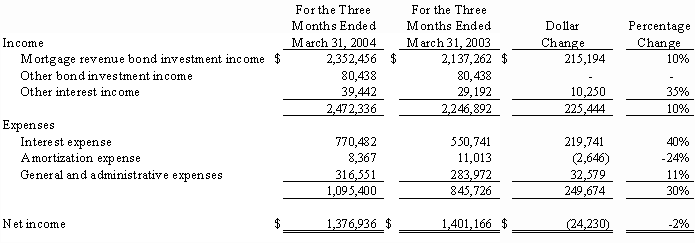
Mortgage revenue bond investment income. Mortgage revenue bond investment income increased due to: (i) earnings of base interest on the Chandler Creek Apartments bond which was acquired in December 2003; (ii) the Fairmont Oaks Apartments bond which was acquired in April 2003; partially offset by (iii) a decrease in past-due base interest earned on the Woodbridge Apartments of Bloomington and Louisville tax-exempt mortgage revenue bonds.
The Partnership earned all of its base interest due in the first quarter of 2004 on all of its tax-exempt mortgage revenue bonds held at March 31, 2004.
Other interest income. Other interest income represents income earned on the Partnership's taxable loans and cash and cash equivalents. The increase is primarily due to an increase in the interest earned on the taxable loan for Clarkson College which provides interim funding for the development of a 140-bed student housing facility which was offset by a decrease in interest income on cash and cash equivalents due to a decrease in the average cash balance and a decrease in interest rates earned on its cash and cash equivalents. It is expected that the taxable loan to Clarkson College will be converted to a tax-exempt mortgage revenue bond during the second quarter; thus, other interest income will decrease in future quarters with a related increase in mortgage revenue bond investment income.
Interest expense. Interest expense on the Partnership's debt financing increased due to (i) the mark-to-market adjustment of interest rate caps as required by FAS No. 133; (ii) the interest expense associated with the securitization transaction to acquire the Fairmont Oaks Apartments tax-exempt mortgage revenue bond in April 2003; (iii) an additional $9,000,000 of debt financing on Northwoods Lake Apartments; and (iv) interest rate cap expense related to the convertible cap agreement purchased in February 2003. These increases were offset by a decline in the variable short-term tax-exempt interest rates. The Partnership's effective interest rate on its debt financing, excluding the effect of marking the interest rate cap agreements to market, was 1.75% for the three months ended March 31, 2004 compared to 1.93% for the three months ended March 31, 2003.
General and administrative expenses. General and administrative expenses increased due primarily to increases in insurance expense, asset management fees, accounting and other fees offset by decreases in tax-exempt mortgage revenue bond servicing fees.
Cash Available for Distribution ("CAD")
To calculate CAD, amortization expense related to debt financing costs and bond issuance costs, interest rate cap expense, provision for loan losses, realized losses on investments and net income (loss) from VIEs are added back to the Partnership's net income as computed in accordance with accounting principles generally accepted in the United States of America ("GAAP"). The Partnership uses CAD as a supplemental measurement of its ability to pay distributions.
There is no generally accepted methodology for computing CAD, and the Partnership's computation of CAD may not be comparable to CAD reported by other companies.
Although the Partnership considers CAD to be a useful measure of its operating performance, CAD should not be considered as an alternative to net income (loss) or net cash flows from operating activities which are calculated in accordance with GAAP.
The following sets forth a reconciliation of the Partnership's net income (loss) as determined in accordance with GAAP and its CAD for the periods set forth.
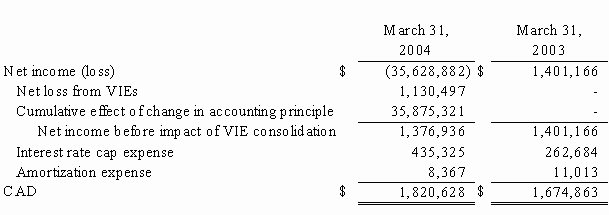
Liquidity and Capital Resources
Tax-exempt interest earned on the mortgage revenue bonds represents the Partnership's principal source of cash flow. Tax-exempt interest is primarily comprised of base interest on the mortgage revenue bonds. The Partnership will also receive from time to time contingent interest on the mortgage revenue bonds. Contingent interest is only paid when the underlying properties generate excess cash flow, therefore, cash in-flows are fairly fixed in nature and increase when the underlying properties have strong economic performances and when the Partnership acquires additional tax-exempt mortgage revenue bonds.
The Partnership's principal uses of cash are the payment of distributions to BUC holders, interest on debt financing and general and administrative expenses. The Partnership also uses cash to acquire additional investments. Distributions to BUC holders may increase or decrease at the determination of the General Partner. The Partnership is currently paying distributions of $0.54 per BUC per year. The General Partner determines the amount of the distributions based upon the projected future cash flows of the Partnership. Future distributions to BUC holders will depend upon the amount of base and contingent interest received on the tax-exempt mortgage revenue bonds and other investments, the effective interest rate on the Partnership's variable-rate debt financing, and the amount of the Partnership's undistributed cash.
The Partnership believes that cash provided by net interest income from its tax-exempt mortgage revenue bonds and other investments, supplemented, if necessary, by withdrawals from its reserve, will be adequate to meet its projected short-term and long-term liquidity requirements, including the payment of expenses, interest and distributions to BUC holders.
The VIEs primary source of cash is cash generated by its real estate investments. Cash generated by the multifamily apartment properties is a function of the net cash flow of the underlying properties. The amount of operating cash generated by the VIEs is substantially dependent on the net rental revenues generated by the properties. Net rental revenues from a multifamily apartment property depend on the rental and occupancy rates of the property and on the level of operating expenses. Occupancy rates and rents are directly affected by the supply of, and demand for, apartments in the market areas in which a property is located. This, in turn, is affected by several factors, such as: local or national economic conditions, the amount of new apartment construction and interest rates on single-family mortgage loans. In addition, factors such as government regulation (such as zoning laws), inflation, real estate and other taxes, labor problems and natural disasters can affect the economic operations of a property.
The VIEs primary uses of cash are: (i) the payment of operating expenses; and (ii) the payment of debt service on the VIEs bonds and mortgage notes payable.
Cash provided by operating activities for the three months ended March 31, 2004 increased $883,584 compared to the same period a year earlier mainly due to timing differences in the payment of accounts payable and accrued expenses. Cash used in investing activities increased $1,350,198 for the three months ended March 31, 2004 compared to the same period in 2003 primarily due to an increase in taxable loans. Cash used in financing activities increased $612,222 for the three months ended March 31, 2004 compared to the same period in 2003 primarily due to the increase in restricted cash which was offset by the fact that the Partnership did not acquire an interest rate cap agreement as it did in February of 2003.
The following table sets forth information relating to cash distributions paid per BUC holder for the quarters ended March 31, 2004 and 2003:

Contractual Obligations
The Partnership restructured its $9 million short-term financing to longer term debt financing during the three months ended March 31, 2004.
Item 3. Quantitative and Qualitative Disclosures About Market Risk.
The Partnership's primary market risk exposures are interest rate risk and credit risk. The Partnership's exposure to market risks relates primarily to its investments in tax-exempt mortgage revenue bonds and its debt financing.
Interest Rate Risk
Interest rates are highly sensitive to many factors, including governmental, monetary and tax policies, domestic and international economic and political considerations and other factors beyond the Partnership's control. The nature of the Partnership's investment in the tax-exempt mortgage revenue bonds and the debt financing used to finance these investments exposes the Partnership to financial risk due to fluctuations in market interest rates. The tax-exempt mortgage revenue bonds bear base interest at fixed rates and may additionally pay contingent interest which fluctuates based upon the cash flows of the underlying property.
As of March 31, 2004, the Partnership had total debt financing outstanding of $76,495,000. The weighted average interest rate of the variable-rate financing was 1.75%, including fees, for the three months ended March 31, 2004.
The stated maturity dates of the Partnership's debt financing are as follows:
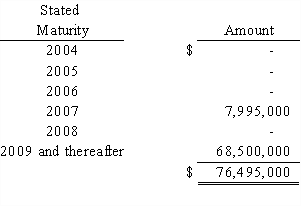
The Partnership is managing its interest rate risk on its debt financing by entering into interest rate cap agreements that cap the amount of interest expense it could pay on its floating rate debt financing as follows:
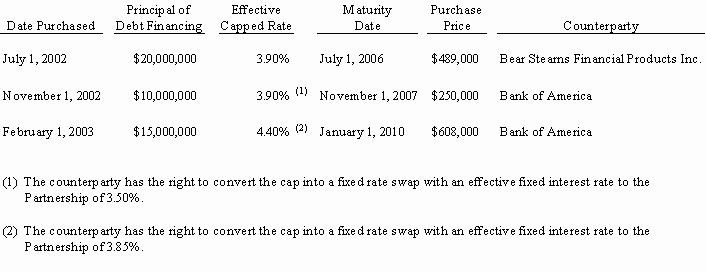
Credit Risk
The Partnership's primary credit risk is the risk of default on its portfolio of tax-exempt mortgage revenue bonds and taxable loans collateralized by the multifamily properties. The tax-exempt mortgage revenue bonds are not direct obligations of the governmental authorities that issued the bonds and are not guaranteed by such authorities or any insurer or other party. In addition, the tax-exempt mortgage revenue bonds and the associated taxable loans are non-recourse obligations of the property owner. As a result, the sole source of principal and interest payments (including both base and contingent interest) on the tax-exempt mortgage revenue bonds and the taxable loans is the net rental revenues generated by these properties or the net proceeds from the sale of these properties.
If a property is unable to sustain net rental revenues at a level necessary to pay current debt service obligations on the Partnership's tax-exempt mortgage revenue bond or taxable loan on such property, a default may occur. A property's ability to generate net rental income is subject to a wide variety of factors, including rental and occupancy rates of the property and the level of operating expenses. Occupancy rates and rents are directly affected by the supply of, and demand for, apartments in the market area in which a property is located. This, in turn, is affected by several factors such as local or national economic conditions, the amount of new apartment construction and the affordability of single-family homes. In addition, factors such as government regulation (such as zoning laws), inflation, real estate and other taxes, labor problems and natural disasters can affect the economic operations of an apartment property.
Defaults on its tax-exempt mortgage revenue bonds and taxable loans may reduce the amount of future cash available for distribution to BUC holders. In addition, if a property's net rental income declines, it may affect the market value of the property. If the market value of a property deteriorates, the amount of net proceeds from the ultimate sale or refinancing of the property may be insufficient to repay the entire principal balance of the tax-exempt mortgage revenue bond or taxable loan secured by the property.
In the event of a default on a tax-exempt mortgage revenue bond or taxable loan, the Partnership will have the right to foreclose on the mortgage or deed of trust securing the property. If the Partnership takes ownership of the property securing a defaulted tax-exempt mortgage revenue bond, it will be entitled to all net rental revenues generated by the property. However, such amounts will no longer represent tax-exempt interest to the Partnership.
The Partnership's primary method of managing the credit risks associated with its tax-exempt mortgage revenue bonds and taxable loans is to perform a complete due diligence and underwriting process of the properties securing these mortgage bonds and loans and to carefully monitor the performance of such property on a continuous basis.
The Partnership is also exposed to a credit risk with respect to its debt financing. All of the Partnership's debt financing has been obtained using securitizations issued through the Merrill Lynch P-Float program. In this program, the senior interests sold are credit enhanced by Merrill Lynch or its affiliate. The inability of Merrill Lynch or its affiliate to perform under the program or impairment of the credit enhancement may terminate the transaction and cause the Partnership to lose the net interest income earned as a result. The Partnership recognizes the concentration of financing with this institution and periodically monitors its ability to continue to perform. In addition, the Partnership's interest rate cap agreements are with two other counterparties. The $20 million rate cap agreement is with Bear Stearns and the $10 million and $15 million rate cap agreements are with Bank of America.
As the above information incorporates only those material positions or exposures that existed as of March 31, 2004, it does not consider those exposures or positions that could arise after that date. The ultimate economic impact of these market risks on the Partnership will depend on the exposures that arise during the period, the Partnership's risk mitigating strategies at that time and the overall business and economic environment.
Cash Concentrations of Credit Risk
The Partnership's cash and cash equivalents are deposited primarily into trust accounts at multiple financial institutions and are not covered by the Federal Deposit Insurance Corporation.
Item 4. Controls and Procedures.
(a) Evaluation of disclosure controls and procedures. The Principal Executive Officer and Principal Financial Officer of America First have concluded, based on their evaluation as of the end of the period covered by this report, that the Partnership's disclosure controls and procedures are effective for gathering, analyzing and disclosing the information the Partnership is required to disclose in the Partnership's reports under the Securities Exchange Act of 1934.
(b) Changes in internal controls. There were no significant changes in the Partnership's internal controls over financial reporting or in other factors that could significantly affect those controls made during the quarter covered by this report, that have, or are reasonably likely to materially affect the Partnership's internal control over financial reporting except as follows:
In response to a material weakness in internal controls over financial reporting identified with respect to the application of FAS No. 133 to its derivative instruments and previously disclosed in the Partnership's December 31, 2003 Annual Report on Form 10-K, the Partnership now obtains fair market value quotations from independent sources as of the end of each reporting period to ensure that the proper mark to market adjustment is recorded for the derivative instruments owned by the Partnership.
PART II - OTHER INFORMATION
Item 6. Exhibits and Reports on Form 8-K.
(a) Exhibits. The following exhibits are filed as required by Item 6(a) of this report. Exhibit numbers refer to the paragraph numbers under Item 601 of Regulation S-K:
3. Articles of Incorporation and Bylaws of America First Fiduciary Corporation Number Five (incorporated herein by reference to Registration Statement on Form S-11 (No. 2-99997) filed by America First Tax Exempt Mortgage Fund Limited Partnership on August 30, 1985).
4(a) Form of Certificate of Beneficial Unit Certificate (incorporated herein by reference to Exhibit 4.1 to Registration Statement on Form S-4 (No. 333-50513) filed by the Partnership on April 17, 1998).
4(b) Agreement of Limited Partnership of the Partnership (incorporated herein by reference to the Amended Annual Report on Form 10-K (No. 000-24843) filed by the Partnership on June 28, 1999).
4(c) Amended Agreement of Merger, dated June 12, 1998, between the Partnership and America First Tax Exempt Mortgage Fund Limited Partnership (incorporated herein by reference to Exhibit 4.3 to Amendment No. 3 to Registration Statement on Form S-4 (No. 333-50513) filed by the Partnership on September 14, 1998).
31.1 Certification of CEO pursuant to Section 302 of the Sarbanes-Oxley Act of 2002.
31.2 Certification of CFO pursuant to Section 302 of the Sarbanes-Oxley Act of 2002.
32.1 Certification of CEO pursuant to Section 906 of the Sarbanes-Oxley Act of 2002.
32.2 Certification of CEO pursuant to Section 906 of the Sarbanes-Oxley Act of 2002.
(b) Reports on Form 8-K.
The Partnership did not file any reports on Form 8-K during the quarter for which this report is filed.
Pursuant to the requirements of the Securities Exchange Act of 1934, the registrant has duly caused this report to be signed on its behalf by the undersigned thereunto duly authorized.
AMERICA FIRST TAX EXEMPT INVESTORS, L.P.
By America First Capital
Associates Limited
Partnership Two, General
Partner of the Partnership
By America First Companies L.L.C.,
General Partner of
America First Capital
Associates Limited
Partnership Two
Date: May 17, 2004 /s/ Lisa Y. Roskens
Lisa Y. Roskens
Chief Executive Officer
EXHIBIT 31.1
Certification of CEO pursuant to Section 302 of the Sarbanes-Oxley Act of 2002
I, Lisa Y. Roskens, certify that:
1. I have reviewed this quarterly report on Form 10-Q of America First Tax Exempt Investors, L.P.;
2. Based on my knowledge, this report does not contain any untrue statement of a material fact or omit to state a material fact necessary to make the statements made, in light of the circumstances under which such statements were made, not misleading with respect to the period covered by this report;
3. Based on my knowledge, the financial statements, and other financial information included in this report, fairly present in all material respects the financial condition, results of operations and cash flows of the registrant as of, and for, the periods represented in this report;
4. The registrant's other certifying officer and I are responsible for establishing and maintaining disclosure controls and procedures (as defined in Exchange Act Rules 13a-15(e) and 15d-15(e)) for the registrant and have:
(a) Designed such disclosure controls and procedures, or caused such disclosure controls and procedures to be designed under our supervision, to ensure that material information relating to the registrant, including its consolidated subsidiaries, is made known to us by others within those entities, particularly during the period in which this report is being prepared;
(b) Evaluated the effectiveness of the registrant's disclosure controls and procedures and presented in this report our conclusions about the effectiveness of the disclosure controls and procedures, as of the end of the period covered by this report based on such evaluation; and
(c) Disclosed in this report any change in the registrant's internal control over financial reporting that occurred during the registrant's most recent fiscal quarter that has materially affected, or is reasonably likely to materially affect, the registrant's internal control over financial reporting; and
5. The registrant's other certifying officer and I have disclosed, based on our most recent evaluation of internal control over financial reporting, to the registrant's auditors and the audit committee of the registrant's board of directors (or persons performing the equivalent functions):
(a) All significant deficiencies and material weaknesses in the design or operation of internal control over financial reporting which are reasonably likely to adversely affect the registrant's ability to record, process, summarize and report financial information; and
b) Any fraud, whether or not material, that involves management or other employees who have a significant role in the Partnership's internal control over financial reporting.
Date: May 17, 2004
/s/ Lisa Y. Roskens
Lisa Y. Roskens
Chief Executive Officer
America First Companies, LLC, acting in its capacity as general partner of the General Partner of America First Tax Exempt Investors, L.P
EXHIBIT 31.2
Certification of CFO pursuant to Section 302 of the Sarbanes-Oxley Act of 2002
I, Mark A. Hiatt, certify that:
1. I have reviewed this quarterly report on Form 10-Q of America First Tax Exempt Investors, L.P.;
2. Based on my knowledge, this report does not contain any untrue statement of a material fact or omit to state a material fact necessary to make the statements made, in light of the circumstances under which such statements were made, not misleading with respect to the period covered by this report;
3. Based on my knowledge, the financial statements, and other financial information included in this report, fairly present in all material respects the financial condition, results of operations and cash flows of the registrant as of, and for, the periods represented in this report.
4. The registrant's other certifying officer and I are responsible for establishing and maintaining disclosure controls and procedures (as defined in Exchange Act Rules 13a-15(e) and 15d-15(e)) for the registrant and have:
(a) Designed such disclosure controls and procedures, or caused such disclosure controls and procedures to be designed under our supervision, to ensure that material information relating to the registrant, including its consolidated subsidiaries, is made known to us by others within those entities, particularly during the period in which this report is being prepared;
(b) Evaluated the effectiveness of the registrant's disclosure controls and procedures and presented in this report our conclusions about the effectiveness of the disclosure controls and procedures, as of the end of the period covered by this report based on such evaluation; and
(c) Disclosed in this report any change in the registrant's internal control over financial reporting that occurred during the registrant's most recent fiscal quarter that has materially affected, or is reasonably likely to materially affect, the registrant's internal control over financial reporting; and
(a) All significant deficiencies and material weaknesses in the design or operation of internal control over financial reporting which are reasonably likely to adversely affect the registrant's ability to record, process, summarize and report financial information; and
(b) Any fraud, whether or not material, that involves management or other employees who have a significant role in the registrant's internal control over financial reporting.
Date: May 17, 2004
/s/ Mark A. Hiatt
Mark A. Hiatt
Chief Financial Officer
America First Companies, LLC, acting in its capacity as general partner of the General Partner of America First Tax Exempt Investors, L.P
Exhibit 32.1
Certification of CEO pursuant to Section 906 of the Sarbanes-Oxley Act of 2002
I, Lisa Y. Roskens, Chief Executive Officer of the general partner of the General Partner of America First Tax Exempt Investors, L.P. (the "Partnership"), certify pursuant to Section 906 of the Sarbanes-Oxley Act of 2002, 18 U.S.C. Section 1350, that:
(1) The Quarterly Report on Form 10-Q of the Partnership for the three months ended March 31, 2004 (the "Report") fully complies with the requirements of Section 13(a) of the Securities Exchange Act of 1934 (15 U.S.C. 78m); and
(2) The information contained in the Report fairly presents, in all material respects, the financial condition and results of operations of the Partnership.
Date: May 17, 2004
/s/ Lisa Y. Roskens
Lisa Y. Roskens
Chief Executive Officer
A signed original of this written statement required by Section 906 has been provided to America First Tax Exempt Investors, L.P. and will be retained by America First Tax Exempt Investors, L.P. and furnished to the Securities and Exchange Commission or its staff upon request.
Exhibit 32.2
Certification of CFO pursuant to Section 906 of the Sarbanes-Oxley Act of 2002
I, Mark A. Hiatt, Chief Financial Officer of the general partner of the General Partner of America First Tax Exempt Investors, L.P. (the "Partnership"), certify pursuant to Section 906 of the Sarbanes-Oxley Act of 2002, 18 U.S.C. Section 1350, that:
(1) The Quarterly Report on Form 10-Q of the Partnership for the three months ended March 31, 2004 (the "Report") fully complies with the requirements of Section 13(a) of the Securities Exchange Act of 1934 (15 U.S.C. 78m); and
(2) The information contained in the Report fairly presents, in all material respects, the financial condition and results of operations of the Partnership.
Date: May 17, 2004
/s/ Mark A. Hiatt
Mark A. Hiatt
Chief Financial Officer
A signed original of this written statement required by Section 906 has been provided to America First Tax Exempt Investors, L.P. and will be retained by America First Tax Exempt Investors, L.P. and furnished to the Securities and Exchange Commission or its staff upon request.